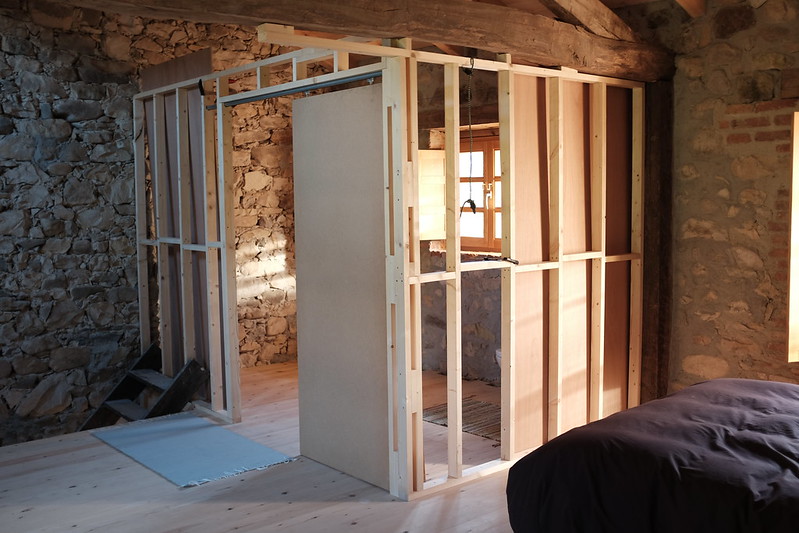Knowing how to assess the extent of water damage is an essential step in how to fix water damaged wood studs. This is to give you a view of how much effort you have to exert to have your wood studs and your walls restored.
Apart from assessing the damage, the instructions talk about cleaning and restoration tips as well. However, before that, we took it upon ourselves to explain what wood studs are and how they acquire water damage to inform you on this subject matter better.

What Are Wood Studs?
Wood studs are part of your house’s framework. They are used to hold up doors and windows. However, you can also use wood studs to separate spaces (e.g., partition walls).
Studs can be made of steel, too, and its use is gaining popularity. Although, in North America, wood is a more typical material used in building studs.
When using wood for studs, they have to be dry. Otherwise, they’ll twist or shrink. You’ll learn more about water damage on wood studs below.
How do they acquire water damage?
As mentioned above, wood studs are used in your house’s framework, and they have to be dry when used. This warning is appropriate during the construction of your house as they are at increased risk of being exposed to the elements.
While drying may not be much of an issue for structures, wood studs may shrink as they dry. Another issue of water damage during construction is mold growth, which will threaten the integrity of your house structure.
Undoubtedly, water damage during construction is a cause of worry. Water damage can also happen after building and in the form of leaking pipes and heavy rains.
Heavy rains and leaking pipes soak walls with water, resulting in a swollen and crumbly wall. The water would then be absorbed further and affect your wooden wall studs, which can affect your home’s structural integrity. Look into the common signs of water damage on wood studs to know what to watch out for below.
Common signs of water damage on wood studs
Since wall studs are part of your home’s framework, they aren’t visible. This also entails that water damage on wood studs cannot be easily detected.
However, wood studs are commonly affected by water damage behind walls, and here are the signs for that:
1. Staining
Water stains are hard to miss, especially if your walls are painted white. This is one of the most easily recognized signs of water damage behind your wall. Also, if it continues to grow in size, it means you are dealing with a plumbing problem.
2. Warped walls
Since wood absorbs water and changes shape because of it, being excessively exposed to water would cause it to warp. If you see this on the walls where your doors and windows are propped, then your wood studs may indeed be water damaged.
3. Mold
You can either detect the mold visually or by the musty smell it produces. While mold is common in bathrooms and basements, it is not common throughout the house. If you see mold growth on your walls, there may be a hidden leak behind your walls, and your wooden studs may be affected.
Steps In Fixing Water Damaged Wood Studs
Step #1. Clean the area
Before proceeding with repairing your water-damaged wood studs, you have to clean the area first. This is mainly done if a flood causes water damage.
Also, document the water damage and compile your receipts. This could make your lawyer’s job on strengthening your insurance claim easier. After talking with your lawyer, contact your insurance company regarding your water damage insurance coverage.
Step #2. Inspect the wall
Assess the damage to your wall and make minor cuts to see the state of your studs. Cut the drywall if the studs are wet to let them dry.
The drying process is long, so you can use dehumidifiers to help hasten the drying process. However, even with the help of fans and dehumidifiers, the studs may take days or weeks to dry.
Step #3. Disinfect the wall
To prevent mold from growing on your wall further, you should disinfect the affected area with a bleach-water solution and let the surface dry. After that, sprinkle baking soda and let it sit for a day. Then, vacuum it after.
Step #4. Rebuild wall
If the water damage is extensive, then replace the whole drywall. However, if the water damage isn’t that huge, then you can use an epoxy filler to fill in the spaces on your drywall.
Make sure to sand before applying the epoxy filler and after using it. Then, properly seal the surface to waterproof it.
After that, sand the area down again. Then, match the paint with the surrounding drywall.
Conclusion
Wood studs form a foundation for your home, so it should be a no-brainer to want to protect them from water damage. However, in cases wherein water damage happens anyway, we hope this article about how to fix water damaged wood studs will help you.
